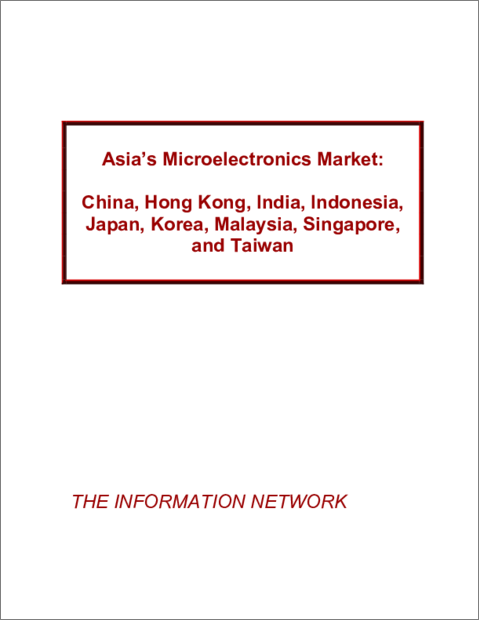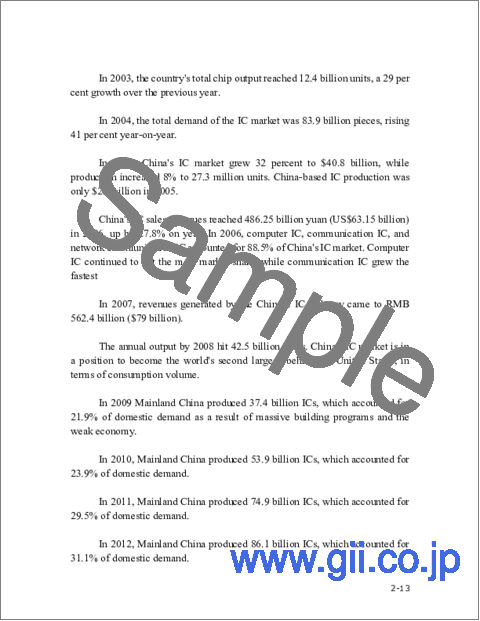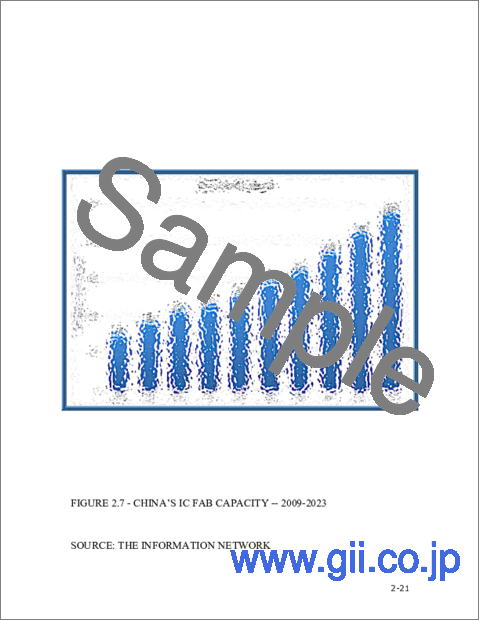|
|
市場調査レポート
商品コード
1483211
アジアのマイクロエレクトロニクス市場:中国・香港・インド・インドネシア・日本・韓国・マレーシア・シンガポール・台湾Asia's Microelectronics Market: China, Hong Kong, India, Indonesia, Japan, Korea, Malaysia, Singapore, and Taiwan |
||||||
|
|||||||
| アジアのマイクロエレクトロニクス市場:中国・香港・インド・インドネシア・日本・韓国・マレーシア・シンガポール・台湾 |
|
出版日: 2025年11月03日
発行: Information Network
ページ情報: 英文
納期: 2~3営業日
|
全表示
- 概要
- 図表
- 目次
イントロダクション
アジアのマイクロエレクトロニクス市場は、急速な発展を遂げるダイナミックな市場であり、顕著な技術革新と各国での幅広い経済活動という特徴があります。
当レポートでは、アジア諸国におけるマイクロエレクトロニクスという重要な産業について包括的に分析し、域内主要国の各々の市場環境や技術動向、戦略的課題を検証しております。また、域内の主な市場促進・抑制要因や、成長・投資のための戦略的機会について考察し、専門的企業に貴重な洞察を提供しております。
アジアのマイクロエレクトロニクス市場の動向
アジアのマイクロエレクトロニクス市場は、域内での急速な技術進歩や世界の半導体産業での中心的役割を反映する、いくつかの主要動向によって牽引されています。最大のプレイヤーである中国は、半導体製造と設計能力への投資を大幅に増やしています。「中国製造2025」のような政府のイニシアティブにより、同国は外国技術への依存を減らし、半導体生産の世界的リーダーになることを目指しています。このため、中国の著名な半導体企業がいくつも台頭し、先進的な製造プロセスや技術の開発にますます注力するようになっています。
日本と韓国は、特にメモリチップとディスプレイ技術の分野で、引き続きマイクロエレクトロニクス市場に大きく貢献しています。日本企業は半導体材料と精密機器の革新で有名であり、韓国の大企業 (Samsung、SK Hynixなど) は最先端のDRAMとNANDフラッシュ技術で世界のメモリ市場を独占しています。これらの国々は、競争力を維持し、AIや5Gなどの新興技術をリードするため、研究開発に多額の投資を行っています。
台湾もまた、先進的な半導体製造能力で世界的に知られる重要なプレイヤーです。台湾積体電路製造 (TSMC) は世界最大の受託チップメーカーで、世界中の大手ハイテク企業向けにチップを製造しています。先端プロセスノードへの注力とファウンドリーサービスにおけるリーダーシップが、台湾のマイクロエレクトロニクス分野の成長を牽引する重要な要因となっています。
シンガポールとマレーシアも半導体製造・組立の重要な拠点です。強固なインフラと良好なビジネス環境を持つシンガポールは、半導体の研究開発と生産に多額の外国投資を引き寄せています。一方マレーシアは、半導体のバリューチェーンにおける組立・検査・パッケージ分野の重要なプレーヤーであり、世界の半導体メーカーに重要なサポートを提供しています。
インドとインドネシアは、マイクロエレクトロニクス分野の新興市場です。インドは熟練した技術者を多く抱え、電子機器の需要が伸びているため、半導体の設計・製造能力の開発に力を入れています。「メイク・イン・インディア」のような政府のイニシアチブは、国内生産を後押しし、輸入依存を減らすことを目的としています。インドネシアは、その戦略的立地と人件費の優位性を活かして外国投資を誘致し、電子機器製造分野での存在感を徐々に高めています。
香港は、アジア全域の電子部品と完成品の流れを促進する重要な物流・貿易ハブとしての役割を果たし続けています。その戦略的地位と高度なインフラが地域のサプライチェーンを支えており、マイクロエレクトロニクス市場にとって不可欠な存在となっています。
目次
第1章 イントロダクション
- アジアの経済動向
第2章 中華人民共和国
- マクロ経済の評価
- 政策の展開
- 将来展望
- マイクロエレクトロニクス産業
- イントロダクション
- エレクトロニクス産業
- IC業界
- 促進要因
- IC組立作業
- IC設計
第3章 香港 (中国)
- マクロ経済の評価
- 政策の展開
- 将来展望
- 情報技術機器産業
- イントロダクション
- 販売チャネル
- 業界動向
- 電子機器の輸出に影響を及ぼす貿易措置
- 中国のWTO加盟
- 製品動向
- 電子部品
- イントロダクション
- 販売チャネル
- 業界動向
- 電子機器の輸出に影響を与える要因
- 製品動向
- 通信機器業界
- イントロダクション
- 販売チャネル
- 業界動向
- 通信機器の輸出に影響を与える要因
- 製品動向
第4章 インド
- マクロ経済の評価
- 政策の展開
- 将来展望
- マイクロエレクトロニクス産業
- イントロダクション
- 半導体製造
- 業界の業績
- 電子機器製造
- 電子設計
- インドのベンチャーキャピタル
- 特別投資プログラム
- イントロダクション
- エレクトロニクスハードウェアテクノロジーパーク (EHTP) スキーム
- ソフトウェアテクノロジーパーク (STP) スキーム
- インドのソフトウェアテクノロジーパーク
- 輸出加工区/100%輸出志向型企業制度
- 承認プロセス
- 政府の承認
第5章 インドネシア
- マクロ経済の評価
- 政策の展開
- インドネシアの地方分権化
- 将来展望
- インドネシアの情報技術インフラ
- イントロダクション
- エレクトロニクス
- 投資家の悪夢
第6章 日本
- マクロ経済の評価
- IT業界
- モバイル市場
- インターネットの利用
- 家電業界
- 日本のIC産業
- 打撃を受けた業界
- 日本の優れた半導体産業
- 半導体装置市場
第7章 大韓民国
- マクロ経済の評価
- 政策の展開
- 将来展望
- IT業界
- イントロダクション
- 通信
- インターネット
- 半導体産業
- イントロダクション
- DRAM業界
- フラッシュメモリ業界
- 半導体施設
- 半導体供給業界
- パッケージ業界
第8章 マレーシア
- マクロ経済の評価
- 政策の展開
- 将来展望
- 技術インフラ
- イントロダクション
- マレーシアのICT産業
- ディスプレイデバイス
- 電子機器・通信機器
- 電子機器受託製造 (EMS)
- 半導体インフラ
- 半導体産業
- 半導体メーカー
第9章 シンガポール
- マクロ経済の評価
- 政策の展開
- 将来展望
- 電子インフラ
- イントロダクション
- EDB (経済開発庁) の産業クラスター - エレクトロニクス
- 半導体産業
- イントロダクション
- 半導体工場
- 半導体装置・材料業界
- 研究開発
第10章 台湾
- マクロ経済の評価
- 政策の展開
- 将来展望
- 半導体産業
- イントロダクション
- 半導体装置・材料
- ICパッケージ・検査
- 半導体工場
- 台湾のIT産業
LIST OF FIGURES
- 2.1. China's GDP
- 2.2. China's IC Production
- 2.3. China's IC Consumption
- 2.4. China's IC Production/Consumption Ratio
- 2.5. China's IC Import Requirements
- 2.6. China's IC Supply/Demand
- 2.7. China's IC Fab Capacity
- 2.8. IC Fab Capacity by Region
- 2.9. China's IC Fab Capacity by Wafer Size
- 2.10. China's IC Fab Capacity by Geometry
- 2.11. China's IC Production by Type
- 2.12. Growth Of China's IC Design Houses
- 3.1. Contributions To Growth (Supply)-Hong Kong
- 4.1. GDP Annual Growth
- 4.2. Electronics Production Profile
- 5.1. GDP Growth-Indonesia
- 5.2. Foreign Investment To Indonesia
- 6.1. Semiconductor Sales by World Region
- 6.2. Semiconductor Equipment Sales by World Region
- 7.1. GDP Growth-Korea
- 7.2. South Korea Internet Speed
- 7.3. Number Of Internet Users
- 8.1. GDP Growth-Malaysia
- 8.2. Malaysia's Industrial Production
- 8.3. Imports of Semiconductors and Electronic Equipment
- 8.4. X-Fab Roadmap
- 8.5. Siltera Malaysia Roadmap
- 9.1. Singapore GDP Growth
- 10.1. Taiwan's Electronic Production
- 10.2. Top Import/Export Regions Of Taiwan IC Market
- 10.3. World Foundry Capacity Breakdown By Country
- 10.4. 300mm Installed Capacity
- 10.5. Equipment Forecast by Region
- 10.6. TSMC's Revenue by Technology
LIST OF TABLES
- 1.1. GDP Growth Developing Asia
- 2.1. Major Economic Indicators-China
- 2.2. China's Electronics Industry
- 2.3. Chinese IC Fab Construction
- 2.4. Chinese Foundry Construction
- 3.1. Major Economic Indicators-Hong Kong
- 3.2. Exports Of Hong Kong's Exports Of IT Equipment
- 3.3. Total IT Equipment Exports By Products
- 3.4. Performance Of Hong Kong's Exports Of Electronics
- 3.5. Total Electronics Components Exports By Major Markets
- 3.6. Total Electronics Components Exports By Products
- 3.7. Performance Of Hong Kong's Exports Of Telecommunications Equipment
- 3.8. Total Telecommunications Exports By Categories
- 3.9. Total Telecommunications Exports By Major Markets
- 4.1. Major Economic Indicators-India
- 4.2. Market Share Of Semiconductor Applications
- 4.3. Electronics Production In India
- 5.1. Major Economic Indicators-Indonesia
- 6.1. Japan's Mobile Subscriber Market
- 6.2. Japanese IC Sales Leaders
- 6.3. Rankings of Top 7 Semiconductor Equipment Companies
- 7.1. Major Economic Indicators
- 7.2. DRAM and NAND Capex Forecast
- 7.3. DRAM Capacity Forecast
- 7.4. 3D-NAND Capacity Forecast
- 7.5. Competitiveness Of Semiconductor Equipment Industry By Country
- 8.1. Major Economic Indicators
- 8.2. Malaysia's IT Industry Billings
- 8.3. Malaysia's Statistics For PCs and Internet
- 8.4. Share Of Total Malaysia Semiconductor Sales
- 9.1. Major Economic Indicators Singapore
- 9.2. Domestic Exports Of Electronics
- 9.3. Semiconductors Trade to United States
- 9.4. Share Of Output
- 10.1. Taiwan's Electronic Production
- 10.2. Major Indices for Taiwan IC Industry
- 10.3. Top 10 Fabless Companies in Taiwan
- 10.4. Major Indices of Taiwan IC Fabrication Business
- 10.5. Top 10 Fabrication Companies in Taiwan
- 10.6. Major Indices Of Taiwan Packaging And Testing Industry
- 10.6. Top 10 Import/Export Regions of Taiwan IC Market
- 10.7. Top 10 IC Packaging And Testing Companies
- 10.8. Market Share of IC Foundries
- 10.9. UMC'S Fabs
- 10.10. Powerchip Semiconductor's Fabs
- 10.11. Production Value Of Taiwan's ICT Industry
Introduction
The microelectronics market in Asia is a dynamic and rapidly evolving landscape, characterized by significant technological advancements and diverse economic activities across various countries. Our report, "Asia's Microelectronics Market: China, Hong Kong, India, Indonesia, Japan, Korea, Malaysia, Singapore, and Taiwan," provides a comprehensive analysis of this crucial sector, examining the unique market conditions, technological trends, and strategic challenges within these key Asian economies. This report is designed to offer valuable insights for industry professionals seeking to understand the regional market dynamics and to identify strategic opportunities for growth and investment.
Trends in Asia's Microelectronics Market
The microelectronics market in Asia is being driven by several key trends that reflect the region's rapid technological advancements and its central role in the global semiconductor industry. China, as the largest player, is significantly increasing its investment in semiconductor manufacturing and design capabilities. With government initiatives like "Made in China 2025," the country aims to reduce its reliance on foreign technology and become a global leader in semiconductor production. This has led to the rise of several prominent Chinese semiconductor companies and an increased focus on developing advanced manufacturing processes and technologies.
Japan and South Korea continue to be major contributors to the microelectronics market, particularly in the areas of memory chips and display technologies. Japanese companies are renowned for their innovation in semiconductor materials and precision equipment, while South Korean giants such as Samsung and SK Hynix dominate the global memory market with cutting-edge DRAM and NAND flash technologies. These countries are investing heavily in R&D to maintain their competitive edge and to lead in emerging technologies such as AI and 5G.
Taiwan is another critical player, known globally for its advanced semiconductor manufacturing capabilities. Taiwan Semiconductor Manufacturing Company (TSMC) is the world's largest contract chipmaker, producing chips for major tech companies around the globe. The country's focus on advanced process nodes and its leadership in foundry services are key factors driving the growth of its microelectronics sector.
Singapore and Malaysia are also important hubs for semiconductor manufacturing and assembly. Singapore, with its robust infrastructure and favorable business environment, attracts significant foreign investment in semiconductor R&D and production. Malaysia, on the other hand, is a key player in the assembly, test, and packaging segment of the semiconductor value chain, providing critical support to global semiconductor manufacturers.
India and Indonesia are emerging markets in the microelectronics sector. India, with its large pool of skilled engineers and growing demand for electronic devices, is focusing on developing its semiconductor design and manufacturing capabilities. Government initiatives like "Make in India" aim to boost domestic production and reduce import dependency. Indonesia is gradually increasing its presence in the electronics manufacturing sector, leveraging its strategic location and labor cost advantages to attract foreign investment.
Hong Kong continues to serve as a crucial logistics and trade hub, facilitating the flow of electronic components and finished products across Asia. Its strategic position and advanced infrastructure support the regional supply chain, making it an integral part of the microelectronics market.
The Need to Purchase This Report
For businesses and professionals operating in or entering the Asian microelectronics market, understanding the regional nuances and growth drivers is essential for strategic decision-making. This report provides a detailed analysis of the market conditions, technological trends, and competitive landscape across key Asian economies. By purchasing this report, stakeholders will gain a comprehensive understanding of the factors shaping the microelectronics industry in Asia, including country-specific opportunities and challenges.
Our report offers strategic recommendations for leveraging market trends and technological advancements to enhance competitive positioning. It includes detailed market forecasts, in-depth evaluations of major industry players, and insights into government policies and economic conditions affecting the microelectronics sector. Companies looking to expand their presence in Asia or to optimize their operations within the region will find this report invaluable for identifying growth opportunities and mitigating risks.
In conclusion, "Asia's Microelectronics Market: China, Hong Kong, India, Indonesia, Japan, Korea, Malaysia, Singapore, and Taiwan" is an essential resource for industry professionals, investors, and business leaders. It provides a thorough exploration of the market dynamics and strategic issues influencing the microelectronics industry in Asia, equipping readers with the knowledge necessary to navigate this complex and rapidly evolving market. By understanding the insights provided in this report, stakeholders can make informed decisions that drive innovation and growth in the Asian microelectronics sector.
Table of Contents
Chapter 1. Introduction
- 1.1. Asian Economic Trends
Chapter 2. People's Republic of China
- 2.1. Macroeconomic Assessment
- 2.2. Policy Developments
- 2.3. Outlook
- 2.4. Microelectronics Industry
- 2.4.1. Introduction
- 2.4.2. Electronics Industry
- 2.5. IC Industry
- 2.5.1. Driving Forces
- 2.5.2. IC Assembly Operations
- 2.5.3. IC Design
Chapter 3-Hong Kong, China
- 3.1. Macroeconomic Assessment
- 3.2. Policy Developments
- 3.3. Outlook
- 3.4. Information Technology Equipment Industry
- 3.4.1. Introduction
- 3.4.2. Sales Channels
- 3.4.3. Industry Trends
- 3.4.4. Trade Measures Affecting Exports of Electronics
- 3.4.5. China's WTO Accession
- 3.4.6. Product Trends
- 3.5. Electronic Components
- 3.5.1. Introduction
- 3.5.2. Sales Channels
- 3.5.3. Industry Trends
- 3.5.4. Factors Affecting Exports of Electronics
- 3.6.5. Product Trends
- 3.6. Telecommunications Equipment Industry
- 3.6.1. Introduction
- 3.6.2. Sales Channels
- 3.6.3. Industry Trends
- 3.6.4. Factors Affecting Exports of Telecom Equipment
- 3.6.5. Product Trends
Chapter 4. India
- 4.1. Macroeconomic Assessment
- 4.2. Policy Developments
- 4.3. Outlook
- 4.4. Microelectronics Industry
- 4.4.1. Introduction
- 4.4.2. Semiconductor Production
- 4.4.3. Industry Performance
- 4.5. Electronic Production
- 4.6. Electronic Design
- 4.7. India Venture Capital
- 4.8. Special Investment Programs
- 4.8.1. Introduction
- 4.8.2. Electronics Hardware Technology Park Scheme (EHTP)
- 4.8.3. Software Technology Park (STP) Scheme
- 4.8.4. Software Technology Parks of India
- 4.8.5. Export Processing Zones/ 100% Export Oriented Units Scheme
- 4.8.6. Process Of Approval
- 4.8.7. Government Approval
Chapter 5. Indonesia
- 5.1. Macroeconomic Assessment
- 5.2. Policy Developments
- 5.3. Decentralization in Indonesia
- 5.4. Outlook
- 5.5. Indonesia Information Technology Infrastructure
- 5.5.1. Introduction
- 5.5.2. Electronics
- 5.6. Investor Nightmare
Chapter 6. Japan
- 6.1. Macroeconomic Assessment
- 6.2. IT Industry
- 6.2.1. Mobile Market
- 6.2.2. Internet Use
- 6.2.3. Consumer Electronics Industry
- 6.3. Japanese IC Industry
- 6.3.1. Battered Industry
- 6.3.2. Japan's Outstanding Semiconductor Sectors
- 6.4. Semiconductor Equipment Market
Chapter 7. Republic of Korea
- 7.1. Macroeconomic Assessment
- 7.2. Policy Developments
- 7.3. Outlook
- 7.4. IT Industry
- 7.4.1. Introduction
- 7.4.2. Telecom
- 7.4.3. Internet
- 7.5. Semiconductor Industry
- 7.5.1. Introduction
- 7.5.2. DRAM Industry
- 7.5.3. Flash Memory Industry
- 7.5.4. Semiconductor Facilities
- 7.5.5. Semiconductor Supply Industry
- 7.6. Packaging Industry
Chapter 8-Malaysia
- 8.1. Macroeconomic Assessment
- 8.2. Policy Developments
- 8.3. Outlook
- 8.4. Technology Infrastructure
- 8.4.1. Introduction
- 8.4.2. Malaysia's ICT Industry
- 8.4.3. Display Devices
- 8.4.4. Electronics Telecommunications Equipment
- 8.4.5. Electronics Contract Manufacturing
- 8.5. Semiconductor Infrastructure
- 8.5.1. Semiconductor Industry
- 8.5.2. Semiconductor Manufacturers
Chapter 9. Singapore
- 9.1. Macroeconomic Assessment
- 9.2. Policy Developments
- 9.3. Outlook
- 9.4. Electronics Infrastructure
- 9.4.1. Introduction
- 9.4.2. EDB Industry Clusters-Electronics
- 9.5. Semiconductor Industry
- 9.5.1. Introduction
- 9.5.2. Semiconductor Fabs
- 9.5.3. Semiconductor Equipment & Materials Industry
- 9.5.4. Research and Development
Chapter 10. Taiwan
- 10.1. Macroeconomic Assessment
- 10.2. Policy Developments
- 10.3. Outlook
- 10.4. Semiconductor Industry
- 10.4.1. Introduction
- 10.4.2. Semiconductor Equipment and Materials
- 10.4.3. IC Packaging & Testing
- 10.4.4. Semiconductor Fabs
- 10.5. Taiwan's IT industry





